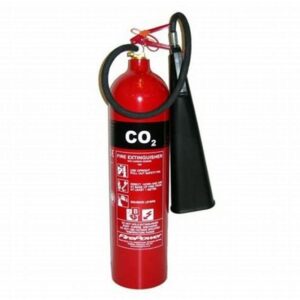CO2 Type Fire Extinguisher
Product Description
The CO2 (Carbon Dioxide) fire extinguisher is a highly effective firefighting tool designed to combat Class B (flammable liquids) and Class C (electrical) fires. It operates by displacing oxygen in the vicinity of the fire, effectively suffocating the flames. The extinguisher is filled with carbon dioxide gas, which is stored in a liquid state under high pressure. When the extinguisher is activated, the CO2 is released, expanding rapidly and cooling the area around the fire. This type of extinguisher is particularly advantageous in environments where electrical equipment is present, as it leaves no residue and does not conduct electricity.
Uses
- Class B Fires: Effective against flammable liquids such as gasoline, oil, and paints.
- Class C Fires: Safe for use on electrical fires involving appliances, wiring, and circuit breakers.
- Laboratories and Workshops: Ideal for use in environments with sensitive equipment, as it does not leave any harmful residue.
- Commercial Kitchens: Useful for extinguishing fires caused by cooking oils and fats.
- Data Centers: Protects critical electronic equipment without causing damage.
Technical Data
| Feature | Specification |
|---|---|
| Type | CO2 (Carbon Dioxide) |
| Capacity | 2 kg, 5 kg, 10 kg, 15 kg |
| Discharge Time | Approximately 30-40 seconds |
| Effective Range | 1.5 to 3 meters |
| Operating Pressure | 55-60 bar |
| Temperature Range | -20°C to +50°C |
| Weight | Varies by capacity (2 kg: 5 kg) |
| Extinguishing Agent | Carbon Dioxide |
| Maintenance | Annual inspection recommended |
| Certification | EN 3, ISO 9001 |
Key Features
- Non-Conductive: Safe for use on electrical fires.
- No Residue: Leaves no mess, making cleanup easy.
- Portable: Lightweight and easy to maneuver.
- Versatile: Suitable for various environments, including homes, offices, and industrial settings.
Conclusion
The CO2 fire extinguisher is an essential safety device for any environment where flammable liquids or electrical equipment are present. Its effectiveness, ease of use, and lack of residue make it a preferred choice for both commercial and residential applications. Regular maintenance and proper training on its use are crucial for ensuring safety and effectiveness in emergency situations.

